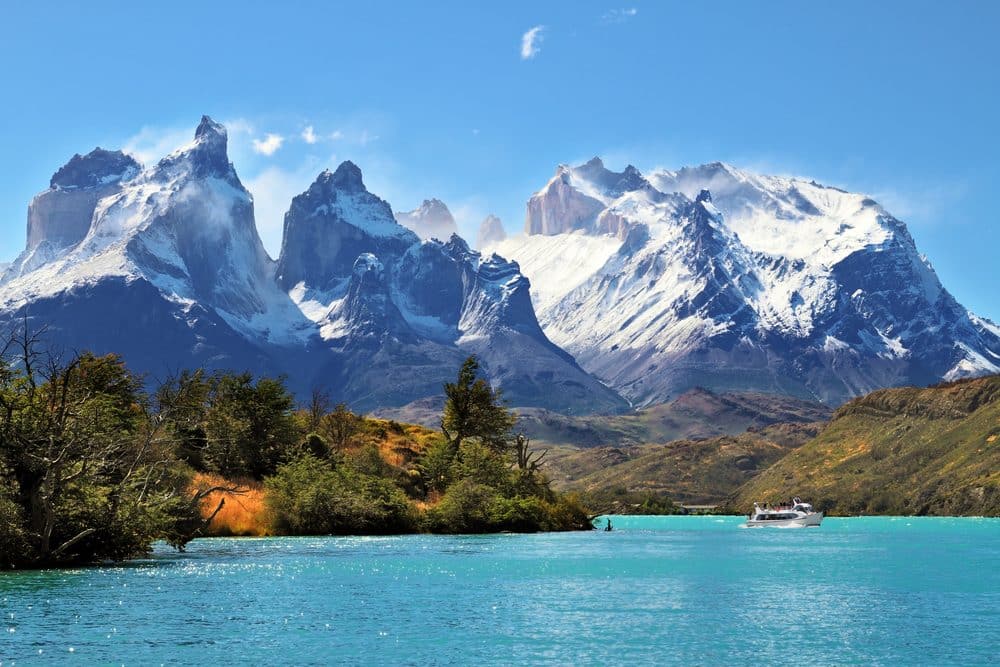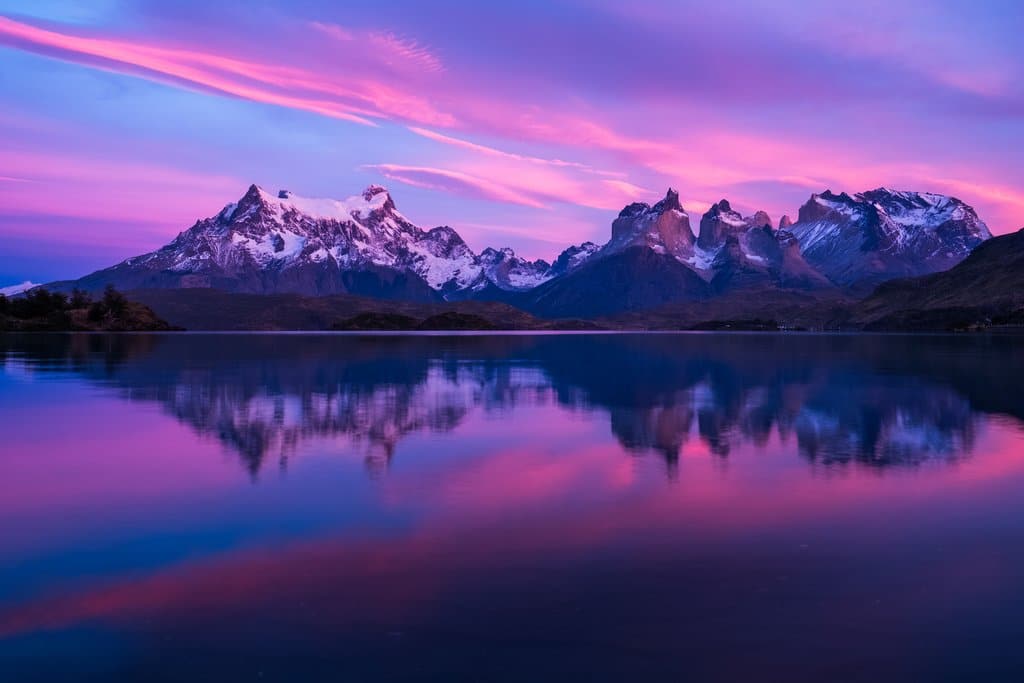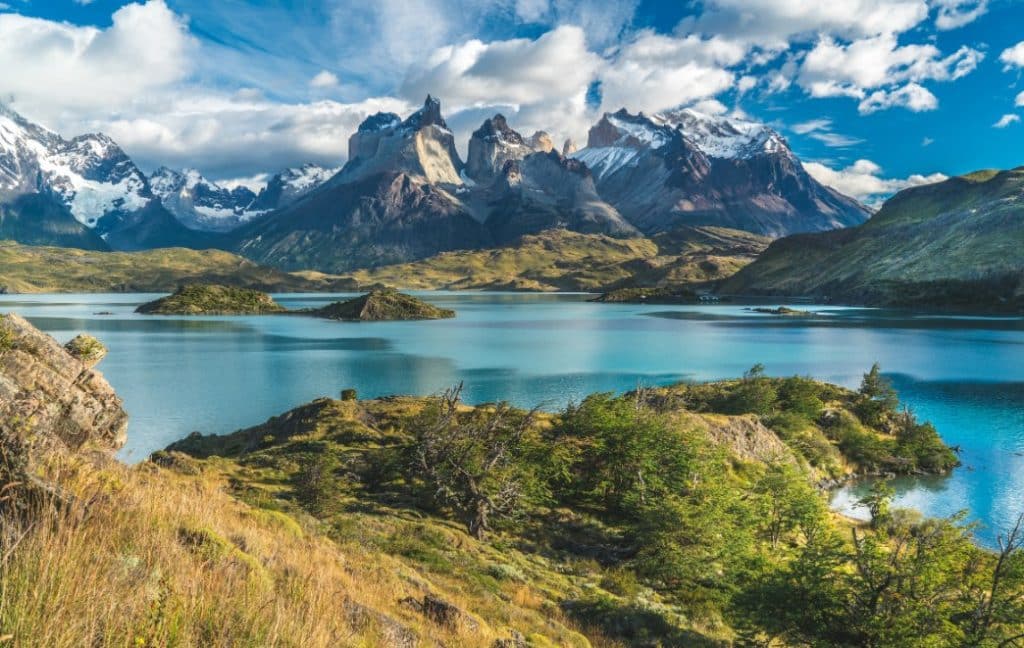Introduction to Torres del Paine, Patagonia, Chile.
Torres del Paine National Park, a jewel in the crown of Chilean Patagonia, offers an unparalleled adventure for nature lovers and trekkers alike. This UNESCO Biosphere Reserve is famed for its breathtaking landscapes, which comprise towering mountains, pristine glaciers, and turquoise lakes.
The park’s name, translating to “Towers of Paine,” references its most iconic landmarks: the three granite peaks of the Paine mountain range, which dominate the skyline.
Established in 1959, Torres del Paine spans over 242,242 hectares, showcasing a diverse ecosystem that includes steppe, Magellanic subpolar forests, and Patagonian tundra.
This variety of habitats supports a wide array of wildlife, from the majestic Andean condor soaring above to the elusive puma roaming the valleys.
The park’s flora is equally diverse, with species adapted to both the wind-swept plains and the sheltered valleys.

Visitors to Torres del Paine are greeted by a landscape that is constantly changing, from the weather to the shifting colors of the sky and land. The park’s dynamic climate adds to its mystery and beauty, with sunshine, rain, and wind often experienced in a single day. This ever-changing environment challenges and delights those who journey through it, making every visit a unique experience.
Torres del Paine is not just a destination; it’s an invitation to explore the wild and rugged heart of Patagonia.
Whether you’re an avid hiker seeking the thrill of the park’s famous treks or a nature enthusiast eager to witness its stunning vistas and wildlife, Torres del Paine offers a myriad of opportunities for adventure and discovery.
How to Get There
Reaching Torres del Paine National Park from Santiago, Chile’s bustling capital, involves a journey through some of the country’s most stunning landscapes, embodying the true spirit of an adventure in Patagonia. The journey to this remote paradise begins with a flight from Santiago to Punta Arenas, the nearest major city to the park. This flight typically takes about three and a half hours, offering passengers their first glimpse of the Patagonian wilderness from above.
Upon landing in Punta Arenas, visitors have several options to continue their journey to Torres del Paine. The most common method is to rent a car or join a guided tour, providing flexibility and the opportunity to enjoy the scenic route at one’s own pace.
The drive to the park takes approximately five to six hours, traversing vast open steppes and passing by herds of guanacos and local estancias (ranches), offering a true sense of the Patagonian expanse.
Alternatively, travelers can opt for a domestic flight from Punta Arenas to Puerto Natales, a town significantly closer to the park. Puerto Natales serves as the gateway to Torres del Paine, located roughly two hours away by road. From here, visitors can take a bus, a shuttle, or a taxi to the park, with several companies offering daily services during the high season.
Entry to Torres del Paine requires a fee, which contributes to the conservation of this pristine natural area.
The park has multiple access points, but the most frequented are Laguna Amarga, Sarmiento, and Pudeto, each offering a unique perspective of the park and its majestic beauty.
Visitors should be mindful of the park’s regulations and weather conditions, which can change rapidly, to ensure a safe and enjoyable experience.
Torres del Paine’s remote location only adds to its allure, making the journey a memorable part of the adventure.
Whether arriving by land or air, visitors are rewarded with breathtaking views and the promise of an unforgettable experience in one of the world’s most spectacular natural settings.
Major Attractions and Trails
Torres del Paine National Park is a trekker’s paradise, offering some of the most stunning trails in the world. The park’s rugged terrain, combined with its natural beauty, makes it a premier destination for outdoor enthusiasts.
Among the myriad of attractions, two treks stand out: the W Circuit and the O Circuit, each offering a unique way to experience the park’s majesty.
W Circuit: Named for its shape, the W Circuit is the most popular trek in Torres del Paine. Spanning approximately 70 kilometers, it can be completed in about 4 to 5 days.
This trek takes hikers through the park’s key highlights, including the Base Torres lookout, offering an up-close view of the iconic towers; the French Valley, surrounded by stunning panoramic views; and the Grey Glacier, where the vast ice field meets the lake.
The W Circuit is accessible to most hikers with a moderate level of fitness and provides a comprehensive overview of the park’s diverse landscapes.
O Circuit: For those seeking a more challenging and less traveled path, the O Circuit encompasses the W Circuit and extends around the Paine Massif. This approximately 110-kilometer trek takes around 7 to 10 days to complete and offers a more in-depth exploration of the park.
The O Circuit allows hikers to experience the remote backside of the massif, with its untouched landscapes and the chance to see the park’s wildlife in their natural habitat. This trek requires a higher level of fitness and preparation but rewards hikers with unparalleled views and a deeper connection to the wilderness of Patagonia.
Beyond these treks, Torres del Paine is home to numerous other attractions, including:
Grey Glacier: A massive glacier that is part of the Southern Patagonian Ice Field. Boat tours offer close encounters with this awe-inspiring ice formation.
French Valley: A spectacular natural amphitheater surrounded by peaks and glaciers, offering one of the park’s best panoramic views.
Los Cuernos: Distinctive horn-shaped peaks that are among the park’s most iconic landmarks.
The park’s diverse ecosystems also support a variety of wildlife, including guanacos, foxes, Andean condors, and, if you’re lucky, the elusive puma.
The combination of its breathtaking trails, unique wildlife, and natural beauty makes Torres del Paine a must-visit destination for nature lovers and adventurers alike.
Planning Your Visit to Torres del Paine
Visiting Torres del Paine National Park is an unforgettable experience that requires careful planning to make the most of your adventure in this pristine wilderness. Here are some essential tips to help you plan your trip:
Best Times to Visit: The best time to explore Torres del Paine is during the Southern Hemisphere’s spring and summer months, from October to April.
During these months, the weather is milder, and the days are longer, providing ample daylight for trekking and exploration. However, these are also the busiest months, so booking accommodations and tours well in advance is advisable.
Accommodation Options: Torres del Paine offers a variety of accommodations, from campsites and refugios (shared lodges) along the trekking routes to luxury hotels outside the park boundaries.
Campsites and refugios provide a closer connection to nature and are ideal for those hiking the W or O Circuits. Meanwhile, hotels and lodges offer more comfort and amenities, suitable for those who prefer day trips within the park.
Sustainable Tourism: As a visitor, it’s crucial to adhere to the park’s rules and guidelines to minimize your environmental impact. Stick to marked trails, dispose of waste properly, and respect wildlife and plant life.
The park’s beauty and biodiversity depend on the responsible behavior of its visitors.
Packing Essentials: The weather in Torres del Paine can be unpredictable, with sudden changes in temperature and conditions. Pack layers of clothing, including waterproof and windproof gear, to stay comfortable. Don’t forget sturdy hiking boots, a sun hat, sunscreen, and sunglasses to protect against the elements.
Additionally, bring a refillable water bottle, as the park’s streams offer some of the purest water in the world.
Safety and Navigation: While the main trails are well-marked, carrying a map and a compass or GPS device is wise for safety. Always inform someone of your trekking plans and estimated return time, especially if venturing into the more remote areas of the park.
By following these tips and planning ahead, your visit to Torres del Paine National Park will be a memorable journey through one of the most spectacular landscapes on Earth.
Whether you’re trekking the iconic circuits, marveling at the glaciers, or simply soaking in the breathtaking vistas, Torres del Paine promises an adventure of a lifetime.
Trekking in Torres del Paine in Chile
Torres del Paine National Park is renowned for its trekking routes, which offer some of the most spectacular wilderness experiences in the world. The park’s trails are designed to cater to a wide range of fitness levels and interests, from short day hikes to challenging multi-day circuits. Here, we explore the two most iconic treks: the W Circuit and the O Circuit.

The W Circuit
The W Circuit is one of the park’s most famous treks, named for its W-shaped route that covers approximately 70-80 kilometers and can be completed in 4 to 5 days. This trek takes hikers through the park’s key attractions, including the Base Torres lookout, French Valley, and Grey Glacier. Each of these locations offers unique landscapes and breathtaking views.
Base Torres: The trek begins (or ends, depending on your starting point) with a challenging hike to the Base Torres lookout, offering up-close views of the park’s iconic granite towers.
French Valley: This segment leads hikers into the heart of the Paine Massif, with panoramic views of the surrounding mountains and hanging glaciers.
Grey Glacier: The trek concludes with a visit to the majestic Grey Glacier, where hikers can witness the vast ice field that feeds into Grey Lake.
The O Circuit
For those seeking a more comprehensive experience, the O Circuit extends the W Trek into a full loop around the Paine Massif, covering about 110 kilometers over 7 to 10 days. This route includes all the highlights of the W Circuit but also takes trekkers through the park’s more remote northern section, offering a deeper immersion into Patagonia’s wild landscapes.
John Gardner Pass: A highlight of the O Circuit is the crossing of the John Gardner Pass, the highest point on the trek.
From here, hikers have stunning views of the Southern Patagonian Ice Field, one of the largest ice masses outside the polar regions.
Remote Wilderness:
The northern part of the O Circuit traverses less frequented paths, providing a sense of solitude and connection with the untouched nature of Patagonia.
Preparation and Tips
Preparation is key to enjoying and completing these treks safely. Hikers should be equipped with suitable gear, including waterproof clothing, sturdy hiking boots, and camping supplies if staying overnight in the park.
It’s also essential to book campsites or refugios (lodges) well in advance, especially during the high season, as spaces fill up quickly.
Environmental stewardship is paramount in Torres del Paine. Hikers are urged to follow Leave No Trace principles, including packing out all trash, staying on marked trails to prevent erosion, and using designated campsites to minimize impact.
Trekking in Torres del Paine offers an unforgettable adventure through some of the most stunning landscapes on Earth. Whether choosing the W Circuit for a shorter journey or embarking on the comprehensive O Circuit, hikers will encounter awe-inspiring sights and the raw beauty of Patagonia.
With proper preparation and respect for the natural environment, this trek can be a highlight of any adventurer’s travels.
Wildlife and Nature Conservation in Torres del Paine
Torres del Paine National Park is not only a trekker’s paradise but also a sanctuary for diverse wildlife and a model for conservation efforts in Patagonia.
The park’s ecosystems range from steppe to forest to the subpolar woodlands, each providing habitat for distinct species. This section delves into the park’s fauna, flora, and the ongoing efforts to protect this unique environment.
Fauna: A Glimpse into Patagonia’s Wildlife
The park is home to an impressive array of wildlife, adapted to life in its rugged landscapes. Perhaps the most iconic of these is the puma, the Patagonian big cat, which roams the park’s vast territories.
Sightings, while rare, are a thrilling experience for visitors. Other mammals include the guanaco, a relative of the llama, which is frequently seen grazing on the steppe, and the elusive Andean deer or huemul, a national symbol of Chile and a species of conservation concern.
Birdwatchers are also drawn to Torres del Paine for its avian diversity, including the majestic Andean condor, with its impressive wingspan, and the Chilean flamingo, which adds a splash of color to the park’s lakes and lagoons.
Raptors such as the cinereous harrier and the black-chested buzzard-eagle are also common, showcasing the ecological richness of the area.
Flora: Vegetation That Adapts and Thrives
The park’s flora is equally diverse, with vegetation zones that vary with altitude, precipitation, and geography.
The wind-swept steppes are covered in hardy grasses and shrubs, while the more protected valleys and slopes host forests of lenga beech and coihue trees. In the spring and summer, the landscape is dotted with wildflowers, including the striking fire bush and the delicate Patagonian orchid, adding to the park’s natural beauty.
Conservation Efforts: Protecting Patagonia’s Wilderness
Conservation is a key focus in Torres del Paine, with efforts aimed at preserving its unique ecosystems and the species that inhabit them. This includes initiatives to control non-native species, reforest areas affected by wildfires, and conduct scientific research to monitor wildlife populations and health. The park’s management practices are designed to balance visitor access with the need to protect and preserve natural resources.
Sustainable Tourism: A Shared Responsibility
Visitors play a crucial role in conservation efforts through responsible tourism practices. This includes staying on designated trails to prevent erosion, adhering to park regulations regarding camping and fires, and minimizing impact by packing out all trash.
By following these guidelines, tourists can help ensure that Torres del Paine remains a pristine and vibrant wilderness for generations to come.
Torres del Paine National Park is a testament to the beauty and diversity of Patagonia’s natural landscapes. Its wildlife and flora, coupled with dedicated conservation efforts, make it a shining example of how humans can coexist with and protect the natural world.
As visitors explore this stunning park, they are reminded of the importance of conservation and the role each individual plays in preserving our planet’s wild places.
Planning Your Visit to Torres del Paine
A trip to Torres del Paine National Park requires careful planning to ensure a memorable and impactful experience. This section covers essential information, including how to get there, accommodation options, entrance fees, and sustainable travel tips, to help you prepare for your adventure in the heart of Patagonia.
Getting There: Access Routes and Transportation
Torres del Paine is remote, but accessible from both Chile and Argentina. The nearest major city on the Chilean side is Punta Arenas, which has an airport with flights from Santiago.
From Punta Arenas, travelers can take a bus or rent a car to reach Puerto Natales, the gateway town to the park. Puerto Natales offers direct bus services to Torres del Paine, making it a convenient base for explorers.
Alternatively, visitors coming from Argentina often fly into El Calafate, then travel by bus or car to the park, crossing the border into Chile. This route offers its own scenic rewards, including views of the southern Patagonian ice fields.
Accommodation: Inside and Near the Park
Options range from camping and refugios (basic lodges) within the park to hotels and hostels in Puerto Natales. Booking accommodation well in advance is crucial, especially during the peak season from November to March.
Campsites and refugios on popular trekking routes like the W Circuit or the O Circuit get booked up quickly, so early planning is essential.
Entrance Fees and Regulations
The park charges an entrance fee, which contributes to its maintenance and conservation efforts. Fees vary depending on the season, with discounts available for children and senior citizens. Visitors should be aware of and comply with park regulations, including rules on camping, fires, and waste disposal, to help preserve the park’s natural beauty.
Sustainable Travel Tips
Sustainability is key to preserving Torres del Paine’s pristine environments. Visitors are encouraged to minimize their impact by sticking to marked trails, carrying out all trash, using water sparingly, and avoiding any disturbance to wildlife.
Choosing eco-friendly tour operators and accommodations that support conservation efforts can also make a positive difference.

Visiting Torres del Paine National Park is an adventure of a lifetime, offering unparalleled access to some of the world’s most spectacular landscapes and wildlife.
By planning your trip thoughtfully and embracing sustainable travel practices, you can enjoy the wonders of Patagonia while ensuring they remain unspoiled for future generations.
Whether you’re trekking the iconic circuits, marveling at the majestic peaks, or simply soaking in the tranquil beauty of the park, Torres del Paine promises an unforgettable experience.
You can read our article about places to visit in the Patagonia Argentina for to plan your next trip.



